
Government inks ₹62,370 crore deal for 97 Tejas Mark-1A jets
What's the story
The Ministry of Defence has signed a ₹62,370 crore contract with Hindustan Aeronautics Limited (HAL) for the procurement of 97 Tejas Mark-1A fighter jets. The deal includes 68 single-seat and 29 twin-seat aircraft along with associated equipment for the Indian Air Force (IAF). Deliveries are expected to start in 2027-28 and will be completed over six years.
Indigenous production
Indigenous content of over 64% in Tejas Mark-1A jets
The Tejas Mark-1A jets will have an indigenous content of over 64%, with 67 new items added to the previous LCA Mk1A contract. This includes advanced systems like UTTAM Active Electronically Scanned Array (AESA) Radar and Swayam Raksha Kavach. According to officials, the project is supported by around 105 Indian companies directly engaged in its execution.
IAF
IAF's current fighter strength is 31 squadrons
Notably, the IAF is already grappling with a massive problem of depleted fighter aircraft squadrons. The IAF's current fighter strength is 31 squadrons, which will be reduced to 29 on September 26, when the MiG-21 is scheduled to retire. Since the mid-1990s, the strength of IAF squadrons has been falling, and with the formal retirement of the MiG-21, the number will be the lowest in the last five or six decades.
Delivery delays
Deliveries of Tejas Mark-1A jets delayed
Similarly, the IAF is experiencing repeated delays, particularly those involving the Tejas Mark-1A fighter jet. Tejas Mark-1A deliveries were expected to begin in March of last year, with at least 16 planes supplied annually. However, the IAF has yet to receive a single jet from HAL. Air Force Chief Amar Preet Singh had earlier expressed concerns over these delays.
Strength expansion
IAF seeks to increase offensive strength beyond mandated limit
According to IANS, the IAF is looking to increase its offensive strength beyond the mandated 42 fighter aircraft squadrons. A defense source said, "Given the situation in the South Asia region and the geopolitical turbulences, top officials and policymakers believe that the mandated strength of 42 fighter aircraft squadrons is not enough." An internal review suggested that this number may increase in future.